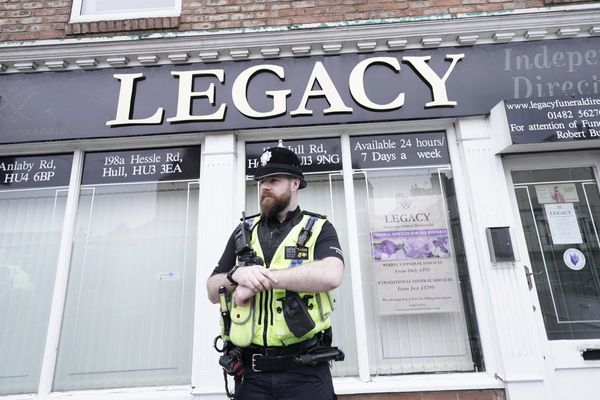
The best jokes on The Simpsons always seem to fly out of nowhere, smacking you in the face like an upturned rake. The TV series that changed animation forever is one of the best there has ever been at mixing low comedy with high, arch cleverness with performative stupidity. Nowhere is this juxtaposition more evident than in the character of Sideshow Bob, the show’s honey-voiced villain whose first sensational appearance turns 30 today.
As voiced by Kelsey Grammer, Bob – or Robert Underdunk Terwilliger, to use his full name – was the perfect Simpsons antagonist. With his polysyllabic vocabulary and love for Gilbert and Sullivan, he was an urbane showman through whom The Simpsons’ Harvard alumni writers could indulge their artier inclinations. But the spiky-haired fiend’s villainy was tempered by a vaudevillian buffoonishness, and he would routinely fall prey to the crudest pratfalls.
When The Simpsons debuted as a standalone series (after appearing in short form on The Tracy Ullman Show) in December 1989, it was an immediate hit. By the end of its first run, it was averaging 27.8 million viewers per episode – a number that subsequent seasons could never match. The fledgling show was on the cover of Newsweek by April.
But, somewhat ironically, its first year was also its roughest. Animation troubles blighted the production schedule (the episode “Some Enchanted Evening” infamously needed about 70 per cent of its animation completely replaced). The music was harsh and distracting (composer Richard Gibbs would be replaced by Alf Clausen from season two onwards), and the voice performances were still a little off-key – Dan Castellaneta’s Homer, for instance, still sounded like a largely unembellished Walter Matthau impression.
Among these first 10 episodes, however, there was one standout: “Krusty Gets Busted”. This marked the first proper appearance of Sideshow Bob (he had appeared with a goofier look, standing mutely next to Krusty the Clown in “The Telltale Head”). Playing out like a twisty legal thriller, the episode revolved around Bob, Krusty’s not-so-trusty sidekick, framing the blue-haired goon for armed robbery, in order to seize control of his kids TV timeslot. The plan works perfectly, until he is foiled by Bart Simpson and his own conspicuously oversized feet.
Dynamic and tautly told, “Krusty Gets Busted” elevated the first season of the show, and laid the groundwork for much of what was to follow. The episode was written by Jay Kogen and Wallace Wolodarsky and directed by Brad Bird, the gifted animator who would go on to direct The Iron Giant, The Incredibles and Ratatouille. It was Bird who was responsible for Sideshow Bob’s design, which sharpened and evolved over the course of production (and of the episode) to better suit Grammer’s smooth baritone.
At the time of “Krusty Gets Busted”, Grammer was working as a regular on Cheers, playing the comically pompous psychiatrist Dr Frasier Crane. He had been initially brought onto the hit sitcom as a guest star – playing the boyfriend of Shelley Long’s Diane Chambers and love rival to Ted Danson’s Sam Malone – but Grammer’s sublime comic timing and confident versatility meant the character was soon upgraded to series regular.
In the original (78-page-long) script for “Krusty Gets Busted”, Sideshow Bob was written with James Earl Jones in mind – drawing from the Star Wars star’s legendary villain kudos. Thanks largely to Sam Simon, the Simpsons co-developer who had worked on the early seasons of Cheers and had made note of Grammer’s mellifluous singing voice on set, the producers were convinced to go with Grammer for the role of Bob, who sang Cole Porter’s “Ev’ry Time We Say Goodbye” at one point during the episode. Jones, meanwhile, would appear in the next season’s “Treehouse of Horror”, reading “The Raven” by Edgar Allen Poe.
With hindsight, it’s hard to imagine anyone else taking on the character, so infused is he with Grammer’s distinct style of fusty erudition. When Bob was brought back, to seduce, marry and (attempt to) kill Marge Simpsons’s sister Selma in season three’s “Black Widower”, the character was fleshed out, given a life outside of show business, and imbued with much more of the Grammerian charm.

Conan O’Brien, who worked on The Simpsons as a writer from 1991 to 1993, said that Grammer was “built to be Sideshow Bob”, saying that he “added a dimension to that character which was uniquely [his]”. In his 2018 book Springfield Confidential, writer Mike Reiss wrote: “Kelsey is every bit as smart as the characters he plays—we’ve never written a Sideshow Bob line so esoteric that he didn’t get it.”
The similarities didn’t end there. “Although he’s not as evil as Bob,” wrote Reiss, “Kelsey is a staunch Republican. And like Sideshow Bob, he did a little jail time in the eighties. I was directing him in a scene where Bob is being shoved into a prison cell and said, ‘I need you to make a noise like you’re being roughed up by cops.’ ‘Oh, I can do that,’ he said with a grin.”
Matt Groening, the cartoonist who created The Simpsons, hit on one of the key reasons for Grammer’s success: “His voice fits in with the regular cast – he doesn’t feel like an outsider.”
Grammer had in fact borrowed Sideshow Bob’s deep, overly theatrical voice from Ellis Raab, a theatre director for whom the Cheers star worked early on in his career, performing odd jobs like hanging wallpaper and painting his bathroom. In several interviews, the Grammer recalls thinking at the time, “this guy… I’m gonna use him someday.”
Part of what made The Simpsons so popular was its pop-culture literacy; episodes would toss around references to all manner of films and TV series, both classic and contemporary. From the start, it was clear that Bob’s cartoonish villainy made him ripe for such parody – at the end of “Krusty Gets Busted”, he is dragged away in a police van screaming lines like an unmasked Scooby Doo ghoul. “Black Widower” used Bob as the pretext to parody Cool Hand Luke and Psycho, and hinged a significant plot point on the character’s dislike of the TV series MacGyver.
But things kicked up a notch with season five’s “Cape Feare”. Widely heralded as one of the series’ finest episodes – and, by extension, one of the finest episodes of TV ever made – “Cape Feare” was an episode-long parody of the 1962 classic Cape Fear, and Martin Scorsese’s 1991 remake of the same name. Casting Sideshow Bob in the Max Cady role, as a deranged killer who gets out of prison and plans revenge (on Bart), “Cape Feare” was the final episode written by the original team of Simpsons writers – a team which, knackered by four years of near-constant work, finally felt they had licence to let loose.

The results were chaotically funny, from the impromptu Gilbert and Sullivan medley that buys Bart time to escape at the end, to the classic, memetic “rake gag”. This fan-favourite sequence, in which Bob unintentionally – and repeatedly – whacks himself in the face with a rake, was the result of the writers needing to fill time (“creative padding”, as Reiss called it), but became an unforgettable piece of surrealist comedy.
Grammer himself had only recorded one rake-in-the-face reaction sound, not expecting to hear it nine consecutive times in the finished product. The actor told Vulture in 2019: “I didn’t see the show right away. They actually sent me a tape, But it ended up in a drawer and I didn’t watch it. And then I heard it was funny. And then I heard I actually won an Emmy for it. So I finally got to see it a year or so after the fact.
“But yes, it is actually quite funny,” he added. “It recurs in my life like a bad dream.”
“Cape Feare” also acknowledged the central dynamic at play in Sideshow Bob plotlines: the murderous animosity between Bob and his perennial foil, Bart. Simpsons producer and long-time showrunner Al Jean has likened the dynamic to that of Wile E Coyote and the Roadrunner, with Bob “always inserting himself into Bart’s life”.
Sideshow Bob’s next appearance, in “Sideshow Bob Roberts”, was no less contrived – an extended parody of All the President’s Men in which Bob rigs the election to become Springfield’s Republican mayor. The episode was written by Bill Oakley and Josh Weinstein, writers who had been Simpsons nerds before getting taken on board with the show. Oakley and Weinstein would graduate to the position of showrunners for seasons seven and eight – two of the series’s most popular – and made a point of bringing back Bob twice more.
By this time, Bob had come a long way from his season one beginnings. Weinstein tells me: “Bob went from being a murderously angry former sidekick to a murderously angry refined bon vivant and self-proclaimed ‘sophisticate’ who’s far too intelligent for the residents of Springfield but just can’t stay away.”
According to Weinstein, writing for Bob “was always a challenge, because we had to figure out a new way and reason for him to break out of prison and wreak havoc on the Simpson family – thus our political take with ‘Sideshow Bob Roberts’. It seems prescient nowadays, but really, we just thought, ‘Hmm... what if the Springfield Republican party needed a new candidate for mayor... and Sideshow Bob was the perfect candidate?’
“It was really fun to figure out these new angles for Bob,” he adds. And for the next few seasons, The Simpsons’ writing staff kept succeeding in figuring out new angles, from “Sideshow Bob’s Last Gleaming”, which cast Bob as a Dr Strangelove-esque Cold War supervillain waging a war on television, to “Brother From Another Series”, which brought in Grammer’s Frasier sibling David Hyde Pierce to play Bob’s brother, Cecil.
“Brother From Another Series” leaned heavily into the two stars’ Frasier personas, and subverted the formula by casting Bob as Bart’s unlikely saviour, and Cecil as the murderous Terwilliger, who harbours a lifetime of bitterness at being passed over for the role of Krusty’s stooge. Grammer has declared it his favourite Bob episode, and it’s easy to see why.

Since then, there have been several other outings for the character, putting Bob in new situations and pairing him up with different characters, like Homer (in “The Great Louse Detective”) and Lisa (in season 25’s “The Man Who Grew Too Much”). In one non-canonical Treehouse of Horror episode, Bob even manages to achieve his ambition and murder his 10-year-old nemesis – the kind of shock-value plotline The Simpsons mocked years earlier when it depicted a rapt Bart and Lisa huddled around the TV, waiting for a similar Itchy and Scratchy stunt (“This is the one where Scratchy finally gets Itchy”).
None of Bob’s appearances in the past two-and-a-half decades have had the impact of “Cape Feare”, but there’s still an indefatigable fondness for the character, among fans and creators alike. As Weinstein puts it: “Kelsey Grammar and what he brings to the role is what makes this character so delightfully special. There were and are a few Simpsons semi-regulars, like Kelsey, Albert Brooks, Marcia Wallace and, of course, Phil Hartman, who – even though they didn’t appear in every episode – were so special to us that they became beloved members of our Simpsons family.
“Sideshow Bob is the character gift that keeps giving,” he continues. “It may be tough to come up with the perfect Bob story but when you do, boy, does it sing. Like Sideshow Bob can sing. Just watch out for those rakes.”







